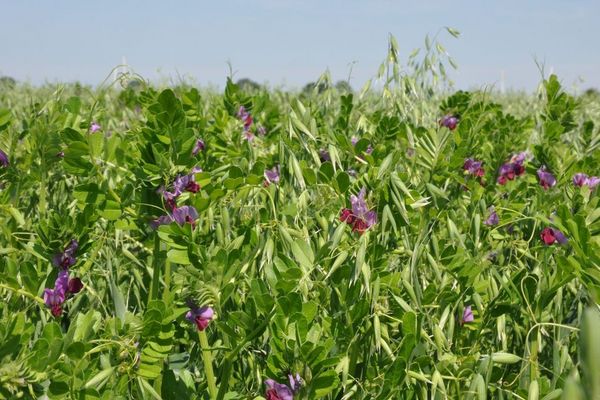Dossier
Public benefits of organic agriculture for environment and society
Jürn Sanders und Heike Kuhnert | 09.03.2023
Organic agriculture provides numerous societal services for environmental protection and resource conservation. This is the result of a study by the Thünen Institute with other research partners published in 2019.
Organic farming is considered to be a sustainable land use system and is therefore specifically supported by policy. Although the interactions between organic farming and the resulting societally relevant environmental benefits have gained more widespread recognition, the potential of organic farming to contribute to environmental and resource challenges of our time are still assessed differently in science and politics.
One reason for this are the different views on the unit of reference to be chosen - i.e. whether an environmental service should be related to the area or the yield. Another recurring topic of discussion is the question of what actually constitutes a societal or public service and which research design should be used to investigate it.
In an interdisciplinary joint project, the Thünen Institute, together with other research partners, analysed the societal benefits of organic farming in the areas of water conservation, soil fertility, biodiversity, climate protection, climate adaptation, resource efficiency and animal welfare on the basis of a comprehensive analysis of scientific publications.
The review of scientific literature showed that organic farming has advantages over conventional farming in environmental and resource protection. A higher societal performance through organic farming was found especially in the areas of water conservation, soil fertility, biodiversity, climate adaptation and resource efficiency.
No clear picture emerged for animal welfare. With regard to behavior and emotions, advantages of organic animal husbandry are indicated. With regard to animal health, no fundamental differences were found apart from limb and hoof health; management seems to be more decisive here than the farming method.
Organic agriculture shows a high potential for the protection of groundwater and surface water. The evaluated comparison studies show that organic farming could reduce nitrate leaching by 28 % (median) on average.
The avoidance of chemical‐synthetic pesticides in organic agriculture restricts the input of active substances with potentially high environmental toxicity. Due to the restrictive production rules for organic livestock farming regarding veterinary drugs in animal production, organic systems are also expected to have lower impact due.
As far as phosphorus losses to ground and surface waters are concerned, reduced contamination can also be expected due to the organic production standards. However, there were insufficient comparative studies available for a well‐founded statement on phosphorus losses, especially since comparative studies on phosphorus losses due to erosion are lacking.
In summary, in 70 % of the 292 comparison pairs evaluated organic management showed clear advantages in terms of nitrogen and pesticide leaching on groundwater and surface water, compared to conventional farming.
The evaluation of the scientific literature on soil fertility shows clear advantages of organic farming.
The abundance and biomass of earthworm populations were on average (median) 78 % and 94 % higher, respectively, under organic management. In 62 % of the comparison pairs, organic farming was associated with lower acidification in the topsoil (difference totalling 0.4 pH units).
With regard to the content of plant available phosphorus in the top soil, no clear tendency in favour of one farming system or another could be determined. Differences in fertiliser management and various P‐analysis methods make it difficult to interpret the data.
A high penetration resistance of the soil is an indicator for compaction damage. On average, the penetration resistance in organic farming was 22 % lower (median). However, this result is based on only four studies.
Taking all indicators into account, 56 % of the pairs showed advantages for organic farming in terms of soil fertility.
Positive effects of organic farming on biodiversity can be clearly demonstrated for the species groups studied.
On average (median values), species numbers on arable land were 95 % higher under organic management as well as 61 % higher for field seed bank and 21 % higher for field margin vegetation.
In the case of the farmland birds, the number of species was 35 % higher and the abundance 24 % higher (median values) for organic farming. At 23 % and 26 %, respectively, these values were higher for flower‐visiting insects. Overall, 86 % (flora) and 49 % (fauna) of the comparison pairs showed distinct advantages through organic farming.
Only two out of 75 studies found negative effects from organic management in 12 out of 312 pairs, based on the classification made. It should be noted that landscape structure has a significant impact on biodiversity, especially on fauna, and this can strongly outweigh the effects of land use.
The comparison of empirical results for soil‐derived greenhouse gas emissions from organic and conventional agriculture in temperate climates shows positive effects from organic management.
On average, organically managed soils have a 10 % higher organic carbon content and a higher annual carbon sequestration rate of 256 kg C/ha. Nitrous oxide emissions are on average 24 % lower according to the studies evaluated. These values result in a cumulative GHG mitigation 1,082 kg CO2e/ha per year from organic farming.
Due to the lack of robust, empirical comparative studies, the yield‐related climate mitigation was assessed qualitatively.
Here, due to lower yields, organic farming probably achieves similar emissions from soil and plants per kg of output as conventional agriculture.
In addition, metabolism‐related methane emissions per kg of milk in organic dairy farming are probably higher than in conventional dairy farming. Total GHG emissions per kg of milk from organic and conventional milk production are considered to be comparable.
Important topsoil properties that contribute to erosion prevention and flood protection have comparable or better values under organic compared with conventional management.
Corg content and aggregate stability were 26 % and 15 % higher on average (median), respectively, in organic farming; infiltration showed a difference of 137 %. Since higher infiltration reduces soil erosion and soil surface water flows, these were also lower under organic farming (‐22 % and -26 % median values, respectively). This was mainly due to the use of clover/grass and lucerne leys. In contrast, no noteworthy differences were found in bulk density (‐4 %).
With regard to the indicators selected to assess climate adaptation performance (i.e. erosion and flood protection), organic farming showed clear benefits at individual plot level (Corg content, aggregate stability, infiltration), and clear expected benefits at the crop rotation level (C‐factor of the Universal Soil Loss Equation) and tentative landscape‐level benefits (surface runoff, soil erosion).
At landscape level, other factors besides agricultural management, such as landscape structure and form, rainfall and discharge regimes play an important role in erosion and flood protection.
The economical use of resources in organic farming, which reduces the burden on the environment, is reflected in nitrogen and energy efficiency. Scientific studies to date show significantly lower nitrogen and energy inputs in organic farming, but also lower nitrogen and energy outputs due to yields.
The nitrogen balances (area‐related nitrogen loss potentials) were substantially lower in organic farming than in conventional agriculture (median ‐40 % to ‐70 % depending on the analysis level).
In 46 % of the comparison pairs, nitrogen efficiency was clearly higher under organic management; for energy efficiency, this was the case for 58 % of comparison pairs. The differences between organic and conventional agriculture were more pronounced at farm level than at crop and crop rotation level.
Across all livestock species and production methods, the results did not provide a clear picture of whether organic is more welfare friendly than conventional husbandry. The evaluated comparative studies focus mostly on single issues and mainly on dairy cows. Animal health was not substantially different except lameness and leg injuries. This indicates that management factors are of greater importance than production system.
Taking all welfare indicators and animal species into account, organic husbandry showed advantages in 34 % of the comparison pairs. No clear differences were found in 46 % of the pairs.
Organic farms perform better if the main risk factors for animal health problems are addressed within the EU Organic Regulations. For example, the requirements for litter and space have a positive effect on lameness and leg health.
Only a few studies take other dimensions of animal welfare into account, such as animal behaviour and emotional state, in addition to animal health. The existing studies indicate animal behaviour and emotional state benefits of organic livestock husbandry, e.g. due to greater space or access to pasture.
Publications
- 0
Sanders J, Brinkmann J, Chmelikova L, Ebertseder F, Freibauer A, Gottwald F, Haub A, Hauschild M, Hoppe J, Hülsbergen KJ, Jung R, Kusche D, Levin K, March S, Schmidtke K, Stein-Bachinger K, Treu H, Weckenbrock P, Wiesinger K, Gattinger A, Heß J (2025) Benefits of organic agriculture for environment and animal welfare in temperate climates. Organic Agric 15(2):213-231, DOI:10.1007/s13165-025-00493-w
- 1
March S, Brinkmann J, Haager D (2021) Public benefits of organic livestock farming as for aspects of animal welfare compared to conventional agriculture - results of a systematic literature review - Vortrag at: Organic World Congress 2021, Science Forum: 6th ISOFAR Conference co-organised with INRA, FiBL, Agroecology Europe, TP Organics and ITAB, Rennes, France, 8 - 10 September, 2021. 4 p
- 2
Sanders J, Brinkmann J, Haager D, March S, Treu H, Heß J, Kusche D, Hoppe J, Hupe A, Schmidtke K, Jung R, Gattinger A, Weckenbrock P, Freibauer A, Levin K, Brandhuber R, Wiesinger K, Hülsbergen KJ, Chmelikova L, Stein-Bachinger K, et al (2019) Im Dienste der Gesellschaft. Ökologie & Landbau(1):46-47
- 3
Brinkmann J, March S, Wagner K, Renziehausen C, Starosta S, Osterbuhr M, Bergschmidt A (2015) Indikatoren für eine ergebnisorientierte Honorierung von Tierschutzleistungen in der Milchviehhaltung. In: Häring AM, Hörning B, Hoffmann-Bahnsen R, Luley H (eds) Beiträge zur 13. Wissenschaftstagung Ökologischer Landbau "Am Mut hängt der Erfolg: Rückblicke und Ausblicke auf die ökologische Landbewirtschaftung". pp 451-454
- 4
Plankl R, Weingarten P, Nieberg H, Zimmer Y, Krug J, Haxsen G (2010) Quantifizierung "gesellschaftlich gewünschter, nicht marktgängiger Leistungen" der Landwirtschaft. Landbauforsch 60(3):173-191
https://literatur.thuenen.de/digbib_extern/bitv/dn046682.pdf
- 5
Niggli U, Schmid O, Stolze M, Sanders J, Schader C, Fließbach A, Mäder P, Klocke P, Wyss G, Balmer O, Pfiffner L, Wyss E (2009) Gesellschaftliche Leistungen der biologischen Landwirtschaft. Frick: Forschungsinstitut für biologischen Landbau (FiBL), 35 p










